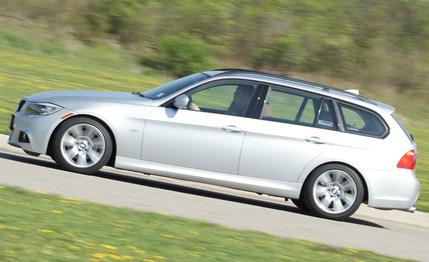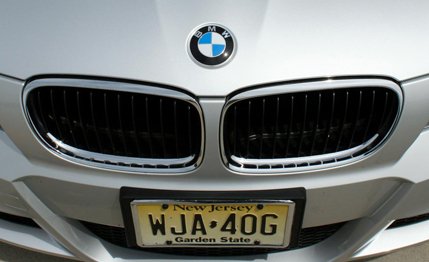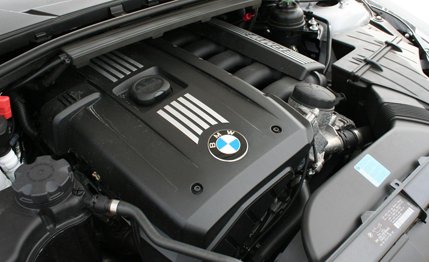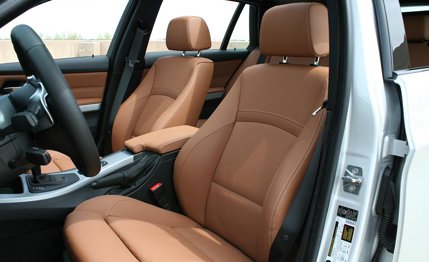
 Short Take Road Test
Short Take Road Test


Extolling the virtues of station wagons is something we at C/D love to do; after all, they combine sedan-like driving dynamics and fuel efficiency with increased utility. But we have to face the reality that the wagon is as endangered in the United States as it’s ever been, and our raves likely serve as eulogies more than anything else. BMW’s own 5-series wagon is a perfect case study. Sold only in 535i xDrive guise here, BMW says just 878 examples—a mere two percent of all 5-series sales—found American owners last year, which wasn’t enough to justify bringing its all-new replacement to our shores. In its place, we get the frumpy not-quite-an-SUV 5-series GT, which, BMW is quick to point out, had already bested last year’s 5-series wagon sales after only three months on the market.
Judging by its 2009 sales, the 3-series wagon likely will suffer the same fate. BMW sold 1430 3-series Sport Wagons last year (546 of them were rear-drive 328i models and 884 were all-wheel-drive 328i xDrives), accounting for—bing!—two percent of 328i sales. When the 3-series is redesigned for 2012, we expect that the forthcoming 3-series GT, similar in concept to the 5-series GT, will kill the slow-selling wagon stateside.
But for the time being, the 328i Sport Wagon remains available. Powering every U.S.-bound 3-series wagon is BMW’s 3.0-liter inline six-cylinder engine that makes 230 hp. Engine-whipping is done by a six-speed manual or an optional six-speed automatic. Our rear-drive 328i Sport Wagon tester came equipped with the automatic ($1375), which isn’t as involving as a manual but offers manual gear selection via the shifter. Steering-wheel-mounted paddles like those on our example are a $100 add-on.
The 3-series wagon is roughly 200 pounds heavier than the sedan, and with the extra weight onboard, the 3.0-liter six sent this five-door from 0 to 60 mph in 6.8 seconds. At low revs, the engine and its 200 lb-ft of torque struggle to create any meaningful thrust. For more urgent acceleration, the key is to keep the revs up, which isn’t a problem because the engine spins freely and never feels stressed. As usual, BMW’s inline-six sounds fantastic, especially as it approaches the 6750-rpm redline.






Dynamically, the wagon is every bit as rewarding to drive as the sedan. Both feel solid and display the same great body control and harmony among the primary controls. The steering, handling, and ride feel exactly as good as a 328i with a trunk. Fuel economy is decent, as well, with this 328i Sport Wagon returning 22 mpg in just over 500 miles. (That is, however, some 10 percent worse than the figure we saw from a manual-equipped 328i sedan.) Throw in the added utility factor, and the wagon shines even brighter.
Of course, you pay a price for the wagon’s extra capaciousness. A 328i sedan starts at $34,025; wagon buyers are asked to shell out at least $36,575. Our test vehicle arrived with a window sticker swelled to $47,895 thanks to a number of luxurious options that we probably would skip, including the extra-cost silver paint ($550), Comfort Access keyless start ($500), power seats ($995), and navigation ($2100). While we could have lived without those items, we’d probably keep the $750 Cold Weather package (heated front seats, headlamp washers, and a ski bag) and the $3750 M Sport package that brings more supportive sport seats, a sport suspension, very attractive 17-inch wheels with performance rubber, Shadowline exterior trim, and front and rear fascias that say M3 rather than Ford Country Squire.
But it’s that sort of faux-wood-lined family-mobile that most people associate with the word wagon, even when they’re presented with one that looks as good and drives as well as this one does. Consider this one of your last chances, America. If we don’t start buying 328i Sport Wagons, they too will go the way of the 5-series wagon—and the Country Squire.